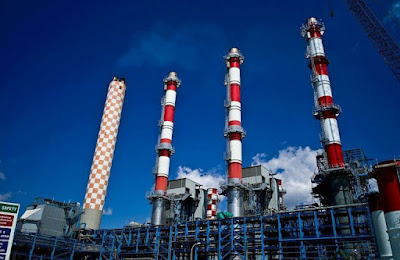Filenews 22 February 2025 - by Angelos Nicolaou
The Republic of Cyprus has submitted the final Compliance Plan for the combustion plants of Dhekelia and Vasilikos Power Stations, in order to comply with the revised European Union Directive on Industrial Emissions. The plan was submitted to the European Commission on 4 February 2025, through the Permanent Representation of the Republic of Cyprus to the European Union. The Compliance Plan concerns the steam plants of Dhekelia Power Station (Dhekelia Power Station) and Vasilikos Power Station (Vasilikos Power Station) of the Electricity Authority of Cyprus (EAC) and includes detailed measures aimed at reducing pollutant emissions and achieving full compliance with regulatory requirements.
This decision was taken after a thorough discussion with the relevant bodies, with the participation and comments of stakeholders, while the final text of the plan incorporates the comments made andis aligned with the guidelines of the National Energy and Climate Plan (NECP). The actions included in the plan aim to balance the need to ensure electricity sufficiency and at the same time reduce the environmental impact of the operation of these plants.
According to the revised NECP, Cyprus has taken into account the need to minimise pollutant emissions from combustion plants, while at the same time embarking on the transition to cleaner forms of energy. The new strategy includes the gradual replacement of fuel with natural gas and the enhancement of electricity production from Renewable Energy Sources (RES).
The plan foresees, inter alia, the upgrading of production capacity through the installation of new natural gas combustion plants, as well as the operation of energy storage systems to enhance the reliability of the power system. In addition, the plan includes a strategy to reduce the operation of steam plants, which will limit their use by 2030, with the aim of reducing emissions and complying with national and European environmental standards.
It is noteworthy that Cyprus, despite the challenges it faces in the power sector due to its isolation, is proceeding with strategic solutions that combine the necessary energy production with environmental protection. In this direction, the use of RES and energy storage technology is expected to be enhanced in the coming years.
With the mission of the Compliance Plan, the Republic of Cyprus invests in the creation of a sustainable and clean energy future, while contributing to the achievement of the European Union's goals for reducing pollutants and protecting the climate.
The text submitted to the European Commission includes a summary of plans to reduce pollutant emissions, switch fuels (e.g. use natural gas instead of heavy fuel oil) and boost energy efficiency by increasing the use of renewables. At the same time, the text describes various policies and measures aimed at enhancing the energy transition and sustainable development of the country.
The text includes specific provisions-commitments:
>> Transition to natural gas for electricity generation in 2026.
>> Boosting production from RES, with the aim of increasing electricity production from Renewable Energy Sources by 2030.
>> Energy upgrading of buildings and promotion of energy efficiency, especially in the public buildings sector, as well as increasing the use of energy storage systems.
This effort reflects Cyprus' strategy to achieve national climate and energy targets, focusing on energy transition, improving energy efficiency and managing pollutant emissions.
Improving efficiency and increasing energy from RES
In summary, the Compliance Plan includes:
Introduction and purpose: The Republic of Cyprus wishes to apply the possibility of derogating from the emission limit values referred to in Directive 2010/75/EU on sulphur dioxide, nitrogen oxides and dust for the combustion plants of the EAC Power Stations in Dhekelia and Vasilikos. In particular, an extension was requested due to the technology of the old units and the need to maintain the security of Cyprus' electricity system until 2030.
Combustion plants:
● The Steam Plants in Dhekelia and Vasilikos use heavy fuel oil, with Dhekelia having units with an electrical capacity of 60MWe and Vasilikos units of 130MWe each.
● The units in Vasilikos have already installed systems to reduce pollutants, but these presented problems, mainly due to the use of heavy fuel oil.
● From 2027, the operation of new combustion plants in Vasilikos is expected with priority given to the use of natural gas.
National Energy and Climate Plan (NECP):
Cyprus is proceeding with actions for the transition to cleaner forms of energy, such as increasing production from Renewable Energy Sources (RES) and upgrading the transmission network.
Reducing dependence on electricity by burning fossil fuels and promoting natural gas and renewables are expected to reduce emissions.
Strategies for compliance:
● Plans to minimize emissions, use natural gas, improve energy efficiency and increase energy from RES.
● At the same time, projects are planned for the installation of photovoltaic systems, wind farms and new energy storage projects.
Demand management:
● It focuses on reducing the consumption of fossil fuels for electricity generation and promoting energy efficiency and renewables.
● Development of energy storage systems, encouragement of energy communities and promotion of measures to reduce energy consumption in public buildings and industries.
The Compliance Plan is a strategy aimed at reducing pollutant emissions and transitioning to more sustainable forms of energy, harmonized with Cyprus' European and international obligations.
The advent of natural gas will reduce pollutant emissions
The gradual reduction of the size and duration of pollutant emissions is expected to be achieved after 2027, with the transition to natural gas and its implementation in the existing units of the Electricity Authority of Cyprus (EAC) at the Vasilikos Power Station. The new Unit No.6 and the combustion plants of the private PEC and Paramount plants in the Vasilikos area are expected to contribute decisively to achieving this reduction. This process will be enhanced by the increasing penetration of renewables and the introduction of storage systems, which are expected to be completed after 2026.
